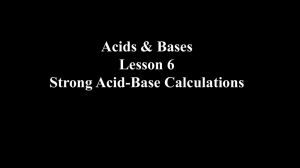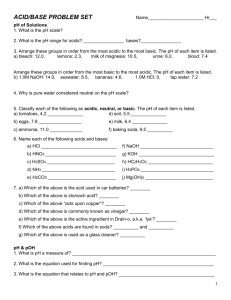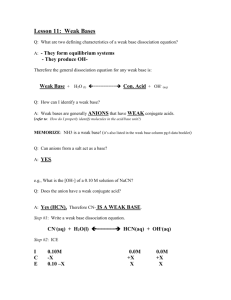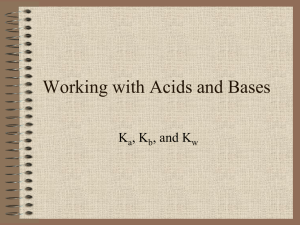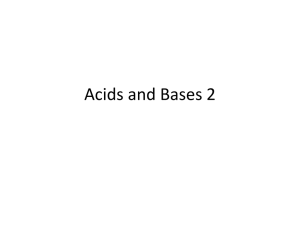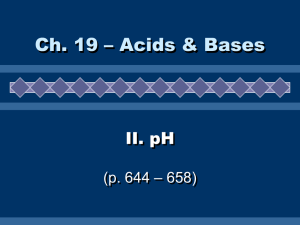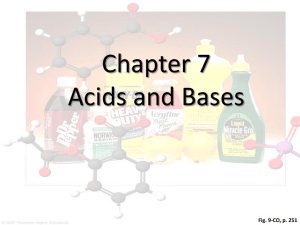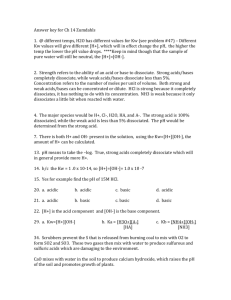23-3-2011
advertisement
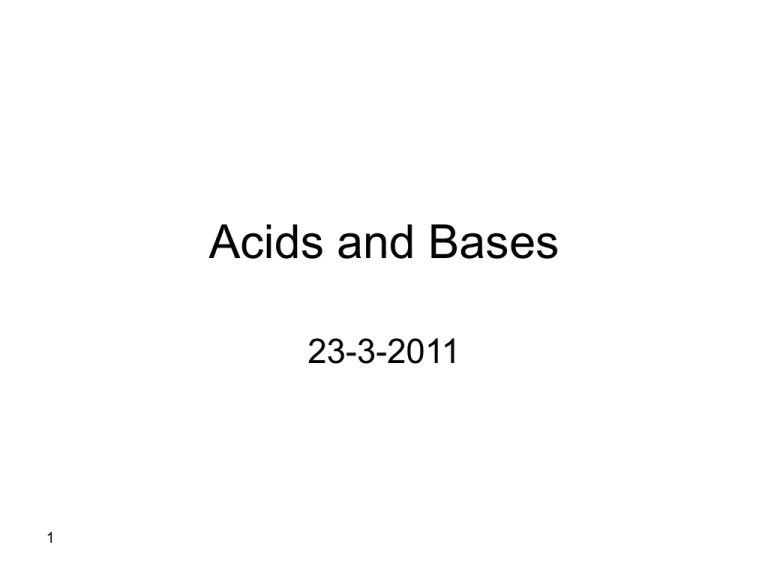
Acids and Bases 23-3-2011 1 Definition of Acids Arrhenius acid: A substance that releases H+ in water ( e.g. HCl) H+ + H2O g H3O+ Hydronium Ion Acid: A substance which increases [H+] when dissolved in water. Base: A substance which increases [OH-] when dissolved in water. 2 Arrhenius Acids - Strong acids completely ionize in water to release H+ (H3O+) and an anion; Strong Acids: HClO4 H2SO4 HI HBr HCl HNO3 HI + H2O g H 3O + + I or HI g H+ + I- (100%) 3 Arrhenius Acids - Weak acids only partially ionize in water; Weak Acids: HC2H3O2 HF HC2H3O2 H3PO4 HCN H2S H+ + C2H3O2- H O H C C O H H 4 HNO2 NH4+ Brønsted-Lowry Acids and Bases The Arrhenius definition does not apply when water is not the solvent; so, a broader definition (Brønsted-Lowry) was generated. Acid: A proton donor Base: A proton acceptor Example: HCl(aq) g H+(aq) + ClH+(aq) + :NH3(aq) g NH4+(aq) 5 Conjugate Acids and Bases: • From the Latin word conjugare, meaning “to join together.” • Reactions between acids and bases always yield their conjugate bases and acids. 6 Examples: HF + HCO3- H2CO3 + F- HF = Acid F- = Conjugate Base HCO3- = Base H2CO3 = Conjugate Acid CH3NH2 + HI g CH3NH3+ + IWhich is conjugate acid & which is conjugate base? I- = conjugate base CH3NH3+ = conjugate acid 7 Strong Acids You will recall that the six strong acids are HCl, HBr, HI, HNO3, H2SO4, and HClO4. These are, by definition, strong electrolytes and exist totally as ions in aqueous solution. For the monoprotic strong acids, [H3O+] = [acid]. 8 Strong Bases Strong bases are the soluble hydroxides, which are the alkali metal and heavier alkaline earth metal hydroxides (Ca2+, Sr2+, and Ba2+). Again, these substances dissociate completely in aqueous solution. 9 Autoionization of Water Autoionization is the self-ionization of a neutral molecule into positive and negative ions. H2O(l) + H2O(l) H3O+(aq) + OH−(aq) What is the equilibrium-constant expression for this equilibrium? 10 The expression is…. 2 H2O H3O+ + OHK = [H3O+][OH-]/[H2O]2 At 25°C, Kw = 1.0 10−14 and [H+] = [OH-] = 10-7 Kw is also called ion-product of water as well as autoprotolysis of water 11 pH Scale In most cases, the hydrogen ion concentration is very small which makes it difficult to practically express a meaningful concept for such a small value. Currently, the pH scale is used to better have an appreciation of the value of the hydrogen ion concentration where: pH = - log [H+] pH + pOH = 14 12 In the case of pure water at 25oC , the pH is 7 and the solution is said to be neutral. 13 What is the concentration of OH- ions in a HCl solution whose hydrogen ion concentration is 0.013 M? Kw = [H+][OH-] = 1.0 x 10-14 [H+] = 0.013 M -14 K 1 x 10 w = 7.7 x 10-13 M [OH-] = + = [H ] 0.013 14 The OH- ion concentration of a blood sample is 2.5 x 10-7 M. What is the pH of the blood? pH + pOH = 14.00 pOH = -log [OH-] = -log (2.5 x 10-7) = 6.60 pH = 14.00 – pOH = 14.00 – 6.60 = 7.40 15 What is the pH of a 2 x 10-3 M HNO3 solution? HNO3 is a strong acid – 100% dissociation. HNO3 (aq) + H2O (l) Start 0.002 M End 0.0 M H3O+ (aq) + NO3- (aq) 0.0 M 0.0 M 0.002 M 0.002 M pH = -log [H+] = -log [H3O+] = -log(0.002) = 2.7 16 More detailed manipulation: Find the pH of a 0.1 M HCl solution. Solution HCl is a strong acid that completely dissociates in water, therefore we have HCl g H+ + ClH2O D H+ + OH[H+]Solution = [H+]from HCl +[H+]from water 17 However, [H+]from water = 10-7 in absence of a common ion, therefore it will be much less in presence of HCl and can thus be neglected as compared to 0.1 (0.1>>[H+]from water) Always neglect [H+]from water when [H+]from ACID is larger than 10-6M [H+]solution = [H+]HCl = 0.1 pH = -log 0.1 = 1 18 Calculate the pH of the solution that is 0.04 M Ca(OH)2 in water. [OH-] = [OH-]Ca(OH)2 + [OH-]water Always neglect [OH-]water when [OH-]base is larger than 10-6M [OH-]Ca(OH)2 = 0.08 M [H+] = 10-14/0.08 = 1.2x10-12 M, Therefore: [OH-] = [OH-]Ca(OH)2 = 0.08 M pOH = 1.097 pH = 14 – 1.097 = 12.9 19 What is the pH of a 1.8 x 10-2 M Ba(OH)2 solution? Ba(OH)2 is a strong base – 100% dissociation. Ba(OH)2 (s) Start 0.018 M End 0.0 M Ba2+ (aq) + 2OH- (aq) 0.0 M 0.0 M 0.018 M 0.036 M pH = 14.00 – pOH = 14.00 + log(0.036) = 12.6 20 The pH of rain water in northeastern United States on a particular day was 4.82. Find [H+]. pH = -log [H+] [H+] = 10-pH [H+] = 10-4.8 [H+] = 1.5*10-5 M 21 Acid - Base Strengths - Two factors influence acid strength: 1) Bond Polarity- The more polar the bond, the stronger the acid. - HCl (∆EN = 0.9) > > H2S (∆EN = 0.4) 2) Bond Strength - The weaker the bond, the stronger the acid. - HI >> HF. HI bond is weaker than that of HF bond. - Bond strength is the larger of the two factors. 22 23 Strength of Oxyacids 24
